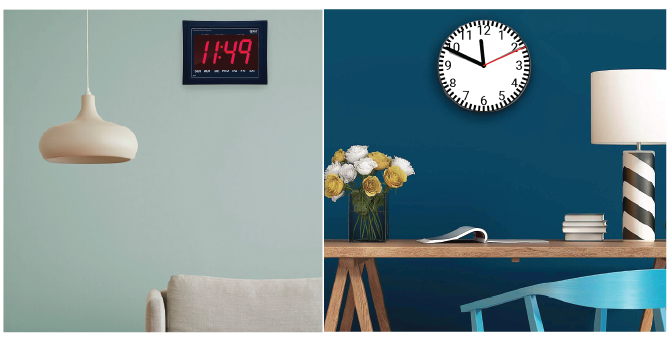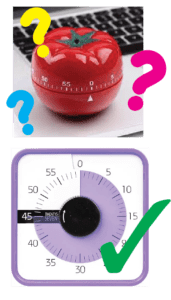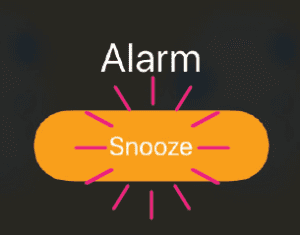You Snooze, You Win! :: Life Hacks For The Time-Management-Challenged
I was once given an art assignment that consisted of a blank sheet of paper with the word “TIME” at the top in bold letters. Our only instruction was to draw in the space below based on the word prompt. I stared at the paper and felt a flood of mixed emotions – both positive and negative.
When it comes to four-letter words, this one might be the most sensational.
I have many positive memories regarding the word time; the way my Cajun Granny would always say, “Well, y’all got time …” when we’d announce we were about to head home after Sunday lunch. She’d start a pot of coffee or get the ice cream out of the freezer to soften, and suddenly, we did have time.
Of course, for many of us, this word brings more panic than pleasant thoughts.
Five fingers up! (I’d do ten, but I don’t want to take up more time than necessary.) Put a finger down for each time-related phrase that makes you feel personally attacked.
- How long have you known about this?
- How much more time do you need?
- Benjamin Franklin had the same 24-hour days that you do.
- We’re in a real-time crunch right now.
- Is this the best use of your time?
I’ve struggled with time management “flaws” and the subsequent judgment, abuse, and shame that comes with it, so I get it.
Many folks have argued that, when it comes to ADHD (Attention Deficit Hyperactivity Disorder), the word “deficit” is misleading. There is no “deficit” of attention when it comes to things that we are interested in. If anything, the opposite is true. Many of our issues involve “management.” Managing time, money, tasks, emotions, and attention.
I raised eyebrows in my son’s IEP last year when I questioned the philosophy behind “extra time on tests.”
“If you had a relative that had issues with managing money, raise your hand if you believe the best way to help that relative would be to give them a bunch of extra money?”
No hands raised.
“Shouldn’t we be teaching our ADHD students better time management skills? How will giving him extra time help if we don’t give him the tools to manage that time??”
But, I digress.
What I am NOT saying: “Because my brain works differently, everyone else will just have to deal with it.”
No! When it comes to navigating life as a social creature meant to live and thrive within a community, it makes sense to respect the time of others while doing your best to manage your own time.
I’m pleased to share a few time-management hacks that have been personal game-changers for me (and have also helped my kids) ::
1. DITCH DIGITAL.
Okay, you don’t have to eliminate all digital clocks, but I have a strong case for having at least one analog in the mix. One day, I was working from home and had to leave at noon to run an errand. Lost in my work, I glanced at the digital clock on my laptop and saw 11:49 a.m. I was annoyed but unfazed. A moment later, I looked up at the analog clock on the wall, and MY HEART SKIPPED.

I could see how close it was to noon, that second hand ticking on without stopping and pushing the big hand closer to 12.
After that day, I started looking at the analog clock more often. I realized that seeing the movement plus the impending time deadline, instead of looking at numbers separated by a colon, was a much more effective procrastination deterrent. It’s helped me ever since.
I finally came to an understanding of how I “perceived” time. As a visual learner and someone who has never met an infographic she didn’t love, I’m sorry I didn’t recognize it sooner. It’s probably because I’d been wallowing in self-criticism.
2. SEEING IS ACHIEVING.


And then, I learned about the “Pomodoro Technique.”
Per Wikipedia, the Pomodoro Technique is a time management method developed by Francesco Cirillo in the 1980s. He used one of those cute tomato-shaped kitchen timers (tomato = pomodoro in Italian) to divide his work into 25-minute intervals separated by short breaks. After some trial and error, the visual timer I found to be the most effective for me is similar to the one pictured. Watching the “purple” disappear has helped me to stay on task. I also like setting a maximum time of 60 minutes, as 25 minutes seems too short for my work style.
3. YOU SNOOZE YOU WIN!


I’ve been a lifelong “strategic snoozer.” Now that we have Alexa, Siri, Hey Google, and all those other “digital assistants,” I’ve taken snoozing to the next level.
My mornings often go like this:
6:15 ALARM
Snooze (Zzzzzzzz)
6:24 ALARM
Snooze again (Zzzzzzz)
6:33 ALARM
Snooze, but don’t go back to sleep.
Browse phone
ALARM … Snooze.
Get up. Stretch. Take dog out.
ALARM … Snooze.
Shower … begin to get lost in shower thoughts…
(Is that the alarm again?)
Exit shower.
Snooze ongoing ALARM
Assemble outfit.
Where are those leggings with the cute detail on the side?
Begin digging through a pile of clothes on chair.
No luck.
Walk into laundry room.
Notice pile of clothes I was supposed to wash the night before.
Sigh.
Reach down to pick up clothes…
ALARM!
And THIS is where the miracle happens:
“Uh oh! You need to get ready for work. This can wait. Stay on task!”
Snooze.
Choose readily available outfit.
Get dressed.
Brush teeth.
Pick out accessories.
Where are those earrings?
Where did I leave them?
Check bathroom counter. Nope.
Check kitchen windowsill. Nope.
Wait – who left a half-eaten bowl of cereal in the sink?
ALARM!
“Uh oh! You need to get ready for work. This can wait. Stay on task!”
Return to bedroom.
Choose next best pair of available earrings.
Etc…
SCENE
My last alarm usually happens when I’m driving to work. Only then do I finally stop the snooze cycle. This has really kept me on track.
Bonus: Alexa doesn’t judge me for snoozing the “Go pick up medicine” reminder for 6 hours. She tells me she will keep reminding me intermittently until I ask her to stop.

















